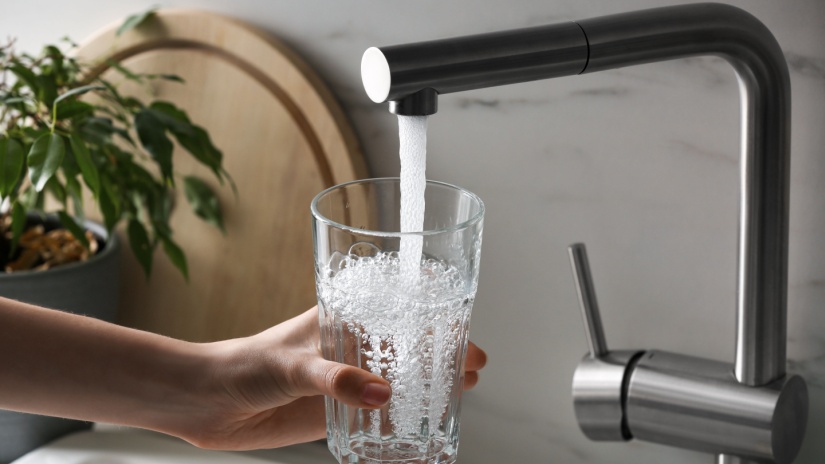Knowledge Centre
Saving your energy bill with a solar hot water system

If your power bill was shockingly high or your hot water system needs replacing, you might be thinking about switching to a solar or heat pump system. Is it worth the upfront cost, and will it really save you money over time? For most homes, the answer is yes.
A well-chosen solar hot water system or heat pump might cost more initially, but they are usually much cheaper to run than conventional electric or gas systems. This is beneficial for both your wallet and the environment. Plus, government rebates and incentives can help offset some of the purchase costs.
As a homeowner, finding ways to cut down on energy expenses is crucial, and heating water is one of the biggest costs, especially during colder months. That's why investing in a solar hot water system is worth considering.
What is a solar hot water system?
A solar hot water system consists of solar collector panels and a storage tank. For a household of four people, typically about four square metres of solar collector area (two panels) and a 300–360L tank are needed. A larger tank is necessary to ensure there is enough hot water on days with less sunlight or when hot water usage is higher than usual.
There are two main types of solar hot water systems: thermosiphon systems and pumped or split systems. Thermosiphon systems have both the collector panels and the storage tank mounted on the roof. In this setup, the liquid in the panels circulates into the tank via the thermosiphon effect, which occurs when heated water becomes lighter and rises into the tank.
On the other hand, pumped or split systems have collector panels on the roof, but the tank is located at ground level or elsewhere in the building. Hot water is pumped from the panels to the tank in these systems.
Gas vs electric boosted solar hot water systems
Solar energy alone often can't provide hot water consistently. During overcast days or in the evening after heavy use, the water in the tank can become too cold. If you want to have hot water always available, the system needs a booster to raise the temperature. This can be done using either an electric element or a gas burner - but what’s the difference?
Electric-boosted systems
Electric-boosted solar hot water systems are generally more affordable upfront. They are especially cost-effective if you have solar panels that help reduce electricity costs.
However, these systems often need to boost water temperature at night, which is when electricity from the grid tends to be more expensive.
The electric booster activates whenever the tank water drops below a certain temperature, regardless of whether hot water is needed at that moment, making it less efficient overall.
Gas-boosted systems
Gas-boosted systems can use natural gas or LPG. While LPG is typically more expensive, it can be a convenient option if you already have LPG bottles in use.
The gas booster usually operates as a continuous flow gas water heater. When you turn on a hot water tap and the tank water is too cold, the heater kicks in to warm the water before it reaches your tap.
This method is often more efficient because it only heats the water on demand, ensuring you have hot water only when you need it.
Benefits of a solar hot water system
Installing a solar hot water system has numerous advantages, primarily harnessing the power of the sun to heat your water, which significantly reduces household electricity bills. With Australia's abundant sunlight throughout the year, it is an ideal location for solar systems.
Cost savings and efficiency
One of the biggest benefits of a solar hot water system is its efficiency. These systems can meet up to 90% of your hot water needs, depending on your location and sunlight exposure.
While the initial investment may be higher than that for conventional hot water systems, the long-term savings on energy bills make it a worthwhile investment.
By reducing reliance on grid electricity, homeowners can see a noticeable drop in their monthly energy expenses.
Environmental impact
Using solar energy for heating water also has a positive impact on the environment. Solar hot water systems help reduce greenhouse gas emissions, contributing to a cleaner, more sustainable future.
By choosing solar, you are not only saving money but also playing a part in reducing your carbon footprint.
Government incentives
The Australian Government supports the adoption of solar hot water systems through various initiatives and rebates.
These incentives can offset some of the initial costs, making the transition to solar more affordable.
Increased property value
Investing in a solar hot water system can also increase the value of your property. Homebuyers are increasingly looking for energy-efficient features, and a solar hot water system is a desirable addition that can make your home more attractive on the market.
Reliability and low maintenance
Solar hot water systems are known for their reliability and low maintenance requirements. Once installed, they provide a consistent supply of hot water with minimal upkeep.
This reliability ensures that you have hot water when you need it, without the frequent maintenance issues associated with some conventional systems.
Are you looking to upgrade your current system and take advantage of those solar credits? Contact the team at Compare Energy and we’ll talk you through the best providers for solar power in your area.
What to consider before you buy
Before purchasing a solar hot water system, it's important to evaluate several key factors to ensure you choose the right system for your needs.
Is your home suitable?
Start by assessing whether your household is suitable for a solar hot water system. Consider the size of your household, the number of occupants, and your daily hot water usage. These factors will influence the type and size of the system you need.
For instance, a larger household with higher hot water demands may require a system with a greater storage capacity and more collector area.
Do you know the types of solar hot water systems out there?
Research the various types of solar hot water systems available to determine which best fits your needs:
- Roof-mounted systems. These systems are installed with both the collector panels and storage tank on the roof, using gravity and natural convection to circulate water.
- Split systems. In these systems, the collector panels are on the roof, while the storage tank is located at ground level or inside the home. Hot water is pumped from the panels to the tank.
- Evacuated tube collectors. Known for high efficiency, these systems use evacuated tubes to capture solar energy and may require less panel area but can be more expensive.
- Heat pump systems. These systems use electricity to transfer heat from the air or ground to the water, making them a good alternative in areas with less direct sunlight.
Is the system big enough?
Consider the storage capacity of the system, which needs to be adequate for your household’s hot water needs. A larger tank is beneficial for accommodating high demand, especially during cloudy days or when multiple showers are taken.
Have you checked whether it has a warranty?
Evaluate the warranties offered by different manufacturers and installers. A good warranty will provide peace of mind and protect your investment. Ensure the system is reliable and well-reviewed by other users.
What solar incentives can you get?
Look into government rebates and incentives available in your area. Programs like solar rebates and Small-Scale Technology Certificates (STCs) can help offset the initial cost of the system. Check the current availability and requirements for these financial aids.
What about installation and maintenance?
It’s important to consider the costs and logistics of installation and ensure you choose a reputable installer who can provide professional setup and support. Also, review the maintenance requirements of different systems to ensure you’re prepared for any ongoing upkeep.
Solar hot water systems: Installation requirements
Installing a solar hot water system involves adhering to certain criteria to guarantee both safety and optimal performance. Key considerations include the positioning and angle of a roof-mounted system, which significantly influence its efficiency.
To maximise effectiveness, the system should be placed in a location with no shading, especially during the winter. For best results, it is advisable to hire a professional for the installation. This ensures the system is set up to high standards and complies with all safety regulations.
What are the costs?
The overall expense for solar and heat pump hot water systems can fluctuate based on several factors, including the system's cost, installation fees, available rebates, and the current price of small-scale technology certificates (STCs) when purchasing.
Fully installed solar hot water systems generally cost between $4000 and $8000. Roof-mounted tank systems are typically more affordable than split systems, and electric-boosted systems are usually cheaper than their gas-boosted counterparts.
Heat pump hot water systems are generally priced between $3000 and $4000 for a complete installation.
What is the payback time for a solar hot water system?
Switching from a gas or electric storage tank system to a solar hot water system or heat pump can cut your hot water costs by at least 50%, and often even more.
The time it takes to recoup the cost of your new system depends on what you're replacing, how much hot water your household uses, and the cost of the new system. Here’s a general overview:
Replacing an electric hot water system
Electric storage tank systems can account for up to 25% of your electricity bill.
If you switch to a solar or heat pump hot water system, you could recover the cost in about five years or less, thanks to the significant savings on your energy bills.
Replacing a gas hot water system
Switching from a gas hot water system to a solar or heat pump system might take a bit longer to pay off.
Gas systems are fairly efficient and, for small households with low hot water needs, a continuous flow gas system is often cost-effective.
However, if you're transitioning to all-electric appliances for environmental reasons or to eliminate your gas account, it may be worthwhile to switch your hot water system as well.
Replacing a gas storage tank with an electric heat pump can be more complex, potentially requiring new electrical circuits or connections.
To estimate potential savings from switching, review your gas bills. A solar hot water system could reduce your gas expenses by about 60% or more, depending on how much of your gas bill is attributed to hot water. For gas systems, the payback period is typically between 5 and 10 years.
To learn more about the costs involved and what you can gain back with solar credits, have a chat with our Aussie-based team at Compare Energy on 1300 790 106.
Solar hot water systems: Government rebates
State government incentives
Various state governments offer programs to promote energy efficiency. To discover available incentives and rebates for hot water systems, give our team a call. We can talk you through the options in your area and with your specific chosen solar provider.
The following state incentives are available for solar or heat pump hot water systems:
Queensland
Queensland was a pioneer among Australian states in adopting solar energy. The Queensland Government Solar Hot Water Rebate enabled many residents to receive up to $1,000 in rebates for installing solar hot water systems.
Although this rebate expired on 22 July 2012, the most significant statewide incentive now available is the qualification for interest-free loans for purchasing a solar hot water system.
Additionally, some homeowners may be eligible for a $200 rebate if they connect their hot water system to an economy tariff. To claim this rebate, solar owners must submit an Electrical Work Request (EWR) to Energex after installation
New South Wales
In New South Wales, there are no state government or private incentives specifically for solar hot water heaters or heat pumps. However, residents can still benefit from the national small-scale technology certificates (STCs) and various no-interest loan programs.
The government offers a free tool to assist residents in switching their energy providers, helping them to save money on their energy bills.
Victoria
While the federal government has provided green energy incentives for over a decade, Victoria has joined the initiative more recently. Since 19 August 2018, any solar hot water heater installed in Victoria can qualify for rebates.
The Victorian government offers up to $1,000 in rebates for solar and heat pump hot water systems through the Solar Homes Program. This rebate can be combined with federal incentives. Additionally, under the Victorian Energy Upgrade Scheme, hot water heaters can receive up to $700 in rebates.
To maximise these benefits, obtain a quote from an accredited local provider before installing your solar hot water heater or heat pump. This will enable you to apply for both the Victorian Solar Homes Program and the Victorian Energy Upgrade Scheme.
Eligibility criteria in Victoria include:
- Applicants who have not previously qualified for the program
- Properties valued under $3 million
- Combined household income below $180,000
- Replacement of a hot water heater that is over 3 years old
Western Australia
Western Australia introduced the Solar Hot Water Heater Subsidy Scheme to assist homeowners in saving hundreds of dollars on solar hot water heaters and heat pumps. Regrettably, this program is no longer available.
South Australia
South Australia has established the Retailer Energy Efficiency Scheme (REES) to encourage residents to install solar hot water heat pumps. Initially launched in 2009 as the Residential Energy Efficiency Scheme, it became fully effective in 2015. The REES program is available to single-family homes, multi-family homes, and small businesses.
Moreover, the city of Adelaide offers an additional rebate of up to $1,000 for solar heat pumps within city limits, which can be combined with REES and STC incentives.
Installing energy-efficient products not only reduces your expenses but also allows you to receive up to $2,000 from the South Australian Government when combined with federal incentives for qualifying solar hot water heaters or heat pumps.
To benefit from REES, homeowners and business owners must arrange an energy audit for their property. Both the hot water heaters and the audit services must receive pre-approval from the state to be eligible for the incentives.
Tasmania
On 1 May 2017, Aurora Energy and the Tasmanian Government introduced the Tasmanian Energy Efficiency Loan Scheme (TEELS). This initiative aimed to support homeowners and business owners in adopting solar hot water systems through interest-free loans. Homeowners could receive no-interest financing ranging from $500 to $10,000, while businesses could borrow up to $40,000.
However, TEELS ended in 2019, coinciding with the closure of the territory’s on-farm energy audit program. Currently, there are no state-sponsored rebates or incentives for solar water heaters in Tasmania.
Northern Territory
In 2018, the Northern Territory launched the Smart Energy Grants program. This $4 million energy efficiency initiative provides a 50/50 split on costs for home improvements involving green technologies, supported by federal funding. Eligible technologies include solar hot water systems, heat pumps, PV solar panels, and batteries.
To determine your eligibility or check the availability of a NT Smart Energy Grant, call our team and we’ll be more than happy to talk you through it.
Federal government incentives
The primary financial incentive for purchasing a new solar or heat pump hot water system comes from the federal government's small-scale technology certificates (STCs) – commonly known as the "solar rebate." This rebate is available throughout Australia. The number of STCs you receive depends on the efficiency of your system and your location.
Generally, the simplest way to use STCs is to sell them to the company supplying your new hot water system. They typically provide a discount on your purchase in exchange for the STCs.
You also have the option to trade the STCs yourself, though this process can be more complex and might not yield better results.
Typically, solar and heat pump hot water systems are eligible for between 20 and 40 STCs. The market value for STCs generally ranges from $30 to $40 each. For a system with 30 STCs at $30 per STC, you would receive $900. Note that different suppliers may offer varying amounts for STCs.
Is a solar hot water system worth it?
Investing in a solar hot water system is a wise choice that can lead to significant savings over time. Before making a purchase, it's important to assess whether your household is a good fit for a solar hot water system and to explore the various types available to find the one that meets your needs. Having the system installed by a certified professional ensures it operates safely and efficiently.
Contact Compare Energy
Given Australia's ample sunlight, a solar hot water system can be a great investment, benefiting both your finances and the environment. Take the first step towards lowering your energy bills by investing in a solar hot water system today and talk to our Compare Energy team.

